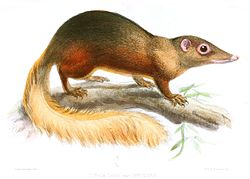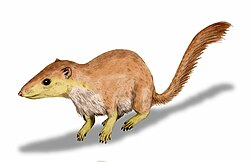| Heterohyus Temporal range: early to late Eocene | |
|---|---|
 | |
| Heterohyus fossil from Messel Pit, Royal Tyrrell Museum of Palaeontology | |
| Scientific classification | |
| Kingdom: | Animalia |
| Phylum: | Chordata |
| Class: | Mammalia |
| Order: | † Apatotheria |
| Family: | † Apatemyidae |
| Genus: | † Heterohyus Gervais, 1848 |
| Type species | |
| †Heterohyus nanus | |
Heterohyus is an extinct genus of apatemyid from the early to late Eocene. A small, tree-dwelling creature with elongated fore- and middle fingers, in these regards it somewhat resembled a modern-day aye-aye.
Contents
Three skeletons have been found at the early Eocene site at Messel Pit, Germany [1]




